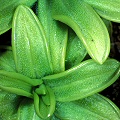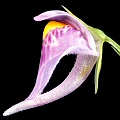From the FAQ Library:
Botanical gardens with carnivorous plants

Pinguicula caerulea The following tremendously incomplete list is just a sample of places where carnivorous plants may be seen in cultivation. I try to restrict this list to those places that have enough carnivorous plants that an enthusiastic beginner would consider worth their effort commuting for a few hours to see it. If you know of a site that is not noted, but that really should be listed, tell me about it by e-mailing me (barry(at)sarracenia.com).
What data do I include? Just the bare bones. If I started to include more information, this page would become unmanageable. (What, do I look like a public relations staffer?) It is up to you to call the garden and find out how to get there, when they are open, or how much it costs.
Information is approximately alphabetically listed in order of Country, then by name--although I'm not that fastidious about this.
Disclaimers, disclaimers, disclaimers

Utricularia calycifida
- Sadly, most botanical gardens do a terrible job of growing carnivorous plants. I limit this list to those places that grow carnivorous plants well (otherwise it would just become a big list of criticisms).
- If I have not been to a site, I indicate it on the review--in these cases I can only report what I have been told.
- These reviews are based only on the public collections--I do not consider collections that are off-limits to the public. Similarly, many gardens or Universities may have large carnivorous plant collections, but with only a small fraction visible to you, the casual grower. The reviews on this page refer only to the public displays.
- With a few notable exceptions I do not include nurseries, even if they have good showrooms.
- The quality of a garden can change rapidly when it changes in management, so let the visitor beware! All too often, I hear that such and such collection of plants lost an important staffer or volunteer, and the carnivorous plant collection has collapsed.
Royal Botanic Gardens (MT. Tomah)
Contact data: Web Site
Comments: This cool climate garden is a satellite of the Royal Botanic Gardens, Sydney (see below). The carnivorous plants are displayed in a bog garden, developed with much assistance from the Australasian Carnivorous Plant Society. I have not visited it.
Royal Botanic Gardens (Sydney)
Contact data: Web Site
Comments: Most of the carnivorous plants are displayed in the Sydney Tropical Centre. I visited it in 2007, and was impressed by the fine collections.
Canada
Jardin Botanique de Montreal/Montreal Botanical Garden (Quebec)
Contact data: Web Site
Comments: Although the public display of carnivorous plants is not extensive, this much-loved site gets consistently high reviews. I have not visited it.
Germany
Bonn
Contact data: Web Site
Comments: A small collection but with some real rarities on show. Outside in the gardens there is a well presented bog garden with a range of temperate carnivorous plants. I have not visited it.
Holland
Hortus Botanicus Leiden/Botanical Garden of Leiden
Contact data: Web Site
Comments: A nice set of carnivores, and a good Nepenthes collection. I have not visited it.
Japan
Yumenoshima Tropical Greenhouse Dome/Tokyo
Contact data: Web Site
Comments: Supposedly 150 plants, including many unique Japanese hybrids. I have not visited it.
UK
Birmingham Botanical Gardens
Contact data: Web Site
Comments: Usually has a fine display of Pinguicula, although I've gotten mixed reviews. I have not visited it.
Cambridge University Botanic Garden
Contact data: Web Site
Comments: Several highland Nepenthes and a a reasonable array of temperate carnivorous plants. I have not visited it.
Down House
Comments: Charles Darwin's home and no doubt a fascinating place worth visiting in its own right. Supposedly, the greenhouse contains a good collection of carnivorous plants. Darwin was very interested in carnivorous plants.
Royal Botanic Gardens, Kew
Contact data: Web Site
Comments: I get two kinds of reports on Kew. Some say it is a good display, mostly in the Princess of Wales Conservatory, although some plants may be in the Alpine house. On the other hand, I quite frequently hear that the collection is dreadful because of the rapid rotation of student curators that are assigned to the carnivores. Perhaps it depends upon your expectations. I have not visited the collections, so cannot mediate the diverging reports.
USA
Balboa Park, San Diego (southern California)
Contact data: Web Site
Comments: A nice raised bog with over 100 carnivorous plants. I visited it years ago and it was in bad shape, but the San Diego Carnivorous Plant Society intervened and--I have been told--made it really nice.
California Carnivores (northern California)
Contact data: Web Site
Comments: The superb showroom of an extraordinary nursery. They accept school groups, etc. Yes, this violates my usual prohibition against putting nurseries on this page, but I the place is great and I like the proprietors. Chalk it up to favoritism.
Chattahoochee Nature Center (Roswell, Georgia)
Contact data: Web Site
Comments: By all accounts, an excellent display of native carnivorous plants in cultivation, and on a boardwalk trail.
Conservatory of Flowers (San Francisco, California)
Contact data: Web Site
Comments: An exceptionally pretty, historical (opened in 1878) Victorian glass house. It is delightful thinking how this conservatory was in operation during the great Nepenthes stovehouse era. The collection currently consists of some excellent pure species and hybrid Nepenthes definitely worth looking at!
Indiana University Greenhouse, Bloomington (Indiana)
Contact data: Web Site
Comments: Reportedly a nice collection of plants, although many are mislabelled. I recommend contacting them before visiting, to make sure they have an existing collection. I have not visited it.
Huntington Library and Botanical Gardens, San Marino (southern California)
Contact data: Web Site
Comments: Reportedly a nice collection, including an artificial bog, and a nice cloud forest room. I have not visited it since the new collections opened. This site has art collections and gardens as part of its attraction.
San Diego Zoo, San Diego (southern California)
Contact data: Web Site
Comments: The zoo has a raised bog with about 40 carnivorous plants. I have not visited the bog yet.
University of California Botanical Garden (in Berkeley) (northern California)
Contact data: Web Site
Comments: A large botanical garden, with a single room displaying a small but well-grown collection of carnivorous plants.
University of California, Davis (northern California)
Contact data: Web Site
Comments: The Botanical Conservatory has a room filled with well-grown plants from many genera.
University of South Florida Botanical Garden (Florida)
Contact data: Web Site
Comments: This site sounds lovely. They have two bog gardens, and they emphasize species native to the USA.
Atlanta Botanical Gardens (Georgia)
Contact data: Web Site
Comments: A marvelous facility with a tremendous collection. One of the finest places to see carnivorous plants in cultivation. Go!
University of Illinois, Champaign (Illinois)
Contact data: Web Site
Comments: A nice collection of Sarracenia grown outside.
Frederik Meijer Gardens (Michigan)
Contact data: Web Site
Comments: The grower for this site, Steve LaWarre, is a purebred carnivorous plant nut. He has developed a very neat carnivorous plant display. I have not been there, but have seen photos. It looks very nice. This collection is part of a much larger garden with artwork, etc., so there should be fun for everyone!
University of Michigan Matthaei Botanical Gardens (Michigan)
Contact data: Web Site
Comments: Supposedly, a nice selection of Nepenthes and a few Drosera. I have not visited it.
Crosby Arboretum, Mississippi State University, Picayune (Mississippi)
Contact data: Web Site
Comments: I have visited here, but the curator has told me that they have a marvelous pitcher plant bog (filled with plants from rescue operations) accessed by a boardwalk. It sounds lovely!
Missouri Botanic Gardens (Missouri)
Contact data: Web Site
Comments: MBG has a great carnivorous plant enthusiast on staff, and I'm sure their collection is excellent. I know they have many genera present in a number of displays. I have not visited it.
North Carolina Botanical Garden (North Carolina)
Contact data: Web Site
Comments: This is a site famed for its excellent carnivorous plant display. They have a nice coastal plain habitat display, as well as an excellent collection of Sarracenia in raised bog gardens.
Longwood Gardens (Pennsylvania)
Contact data: Web Site
Comments: Longwood supposedly has a marvelous display of carnivores. I have not visited it.
Page citations: Personal observations; reader contributions.